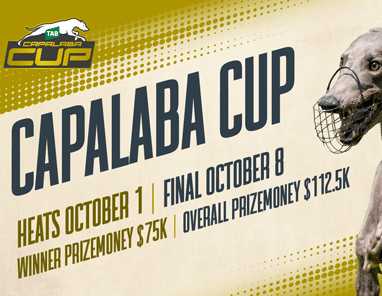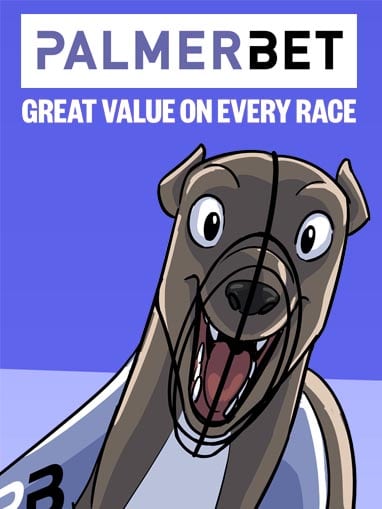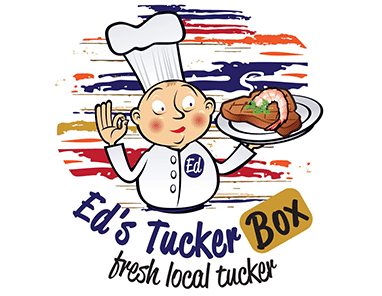
Caption: Mick and Lillian Patterson with their champion He Knows Uno
By MICK PATTERSON
I AM very happy to be asked to give an insight into getting into greyhound racing because it is my belief there has never been a better time for young people to become involved in this industry.
The money to be made these days is great and improving all the time and while that is the initial lure to become involved, there is no better animal with which to bond with.
I plan to make this article about what I do with greyhounds in rearing them, training them and give some ideas on what has worked for me. Hopefully, I will be able to help beginners make some short- cuts to save a bit of the on-going costs etc.
My greyhound racing environment is a home on a quarter of an acre in downtown Iluka, on the NSW north coast.
While everyone in the industry wants to have a property where they can have a big kennel block, dog yards, rearing paddocks and a straight track, not everyone can and that is how I will aim this article.
We, and the dogs, learn to adapt to what we have and I believe this is what newcomers to the industry must do when they buy their first greyhound.
It would be my suggestion that newcomers to our industry go out and buy a couple of well-bred, three-month-old pups, or at least the best their budget can afford. Take them home and enjoy them as I’m certain they will.
Play with those pups, get on well together, get your confidence handling them. As much time you put into those pups, they will give it back to you.
I have bred litters at my Iluka quarter-acre and will keep three and send the others to a rearing farm. But, every month two of those pups will be rotated. It continues until the time comes for them to be educated.
Those pups at my Iluka home, however, never go without exercise. I am very conscious of the need for them to gallop every day and that means a daily visit to the Iluka beach … soft sand or hard. I saw Darren Weir say he had less horse injuries working them on soft sand on the beach then he did with hard sand.
My day starts at 4.45am, every single day. That up and at’ em time is because these days there are more and more people on the beach each day. I am always aware of the problems that can cause. But, at 69 years old, I reckon it keeps me pretty healthy.
Anyone can train a greyhound. It pulls families together. But newcomers just have to have the right principals. The biggest trap is newcomers can have too many dogs and thus cannot give enough effort on what you have got.
When I first started training, I would have raced for ribbons I enjoyed the game that much. I’ve been in the industry for 20 years now.
Newcomers should back their own judgement. If they get a good dog and are offered money to buy it, never regret if you sell or keep.
Ron Ball told me years ago that trainers should never be afraid to take a chance with their dogs, or be different. Have a crack. If it doesn’t work out, so be it. We are all striving to get to a point, to get to the winning post first. If you run second, never criticise the dog. Say to yourself, I’ve got to try harder. In this game, you have got to be competitive.
So, I put that advice into practice some years ago when I won a Group 1 with He Knows Uno. He was a notorious slow beginner in sprints. I thought, how can I get this dog out better. I kept him on the lead all week which is against all the principals I’d learned, the principal of ‘don’t change anything’.
Come the Group 1 final, he began better, got close to the lead and just ran down Octane Show on the line to win. If he had not been close early, he would not have caught Octane Show. It worked for me.
My feeding routine is many and varied. I have got a shelf full of additives that have been there for 10 years or more. Some fad diet led me to buy something, I tried it, found it didn’t work for me, left it there. I am also conscious of the fact newcomers to the industry will be faced with costs getting greater and greater all the time. This is another reason why not to get too many dogs initially.
My dogs are fed butchers meat, human consumption, mixed with fat at a mix of 70/30. I use Coprice kibble three days a week and three slices of toasted wholemeal bred the other days.
I am a great believer in using white rice. All my dogs get a spoonful of rice on their dinner each day, but also a cup full of rice after they have raced. Rice has to be cooked with plenty of water and this is a great rehydration tool.
Many years ago, the great NSW vet John Kohnke told me to help ‘pick up’ a dog, feed them a sloppy stew three days in a row. It works wonders.
I’m also a vege feeder, juiced in a blender, carrots most mornings, celery after a dog races, spinach and the like. One of the greatest flaws in this industry is dehydration and how some trainers do not take it into account.
I’m also a great fan of milk and add it to a weetbix and a small handful of meat for breakfast. Bananas added at this time for potassium is another bonus. Fish too is a marvellous additive. I will buy mullet, boil the heads and bones, strain it and use the jelly that is left to put on the evening meal. It is a fabulous source of Omega 3, 6 and 9.
On race days I will use chicken stock. When travelling with He Knows Uno, he could drink an entire thermos flask of chicken stock during the trip from Iluka to Sydney. During the Golden Easter Egg series he contested, that chicken broth drink on the trip, had his weight perfect at 31.8 three weeks in a row. He ran second in the final.
Of course, there are dogs and then there are dogs. Some are much harder to manage. I regard a good trainer as one who can get the best out of any dog. I think trainers of today are much better educated and prepared. You rarely see a poor looking dog at a racetrack.
There is no substitute for hard work in this industry.
Swimming is a regular part of my training, but I always free gallop my dogs on Iluka beach, trying to make it into a game while still working them hard.
Calcium is another important part of the diet. Vet Gary Carter told me about the importance of supplementing calcium all the time. We should take advice from the people who know what they are talking about. I mix liquid calcium with Sustagen Sports vanilla 50/50.
An important part of my feeding is one ml of Plus Vital, a greyhound syrup which has its main ingredient of molasses, and four days a week a pinch of Ultra Muscle Ease advanced magnesium blend. It is fabulous for any cramping problems.
Other things I will use include Energy E, Iodine drops, Flaxseed Oil and apple cider vinegar.
Feeding and making it appealing to the dog is very, very important.
I’m pretty fanatical about this aspect of training. Newcomers should never be afraid to ask others in the industry for advice. They will respond.
I have recently been approached about bringing some young people, on the wrong side of the tracks, to my kennels to help out, teach them the basics, walk dogs etc. It is a project in the very days of discussion.
Rest assured, greyhounds and greyhound racing is a wonderful opportunity. The riches it can provide are there for everyone to see.
But, the rewards can come just from being involved.









